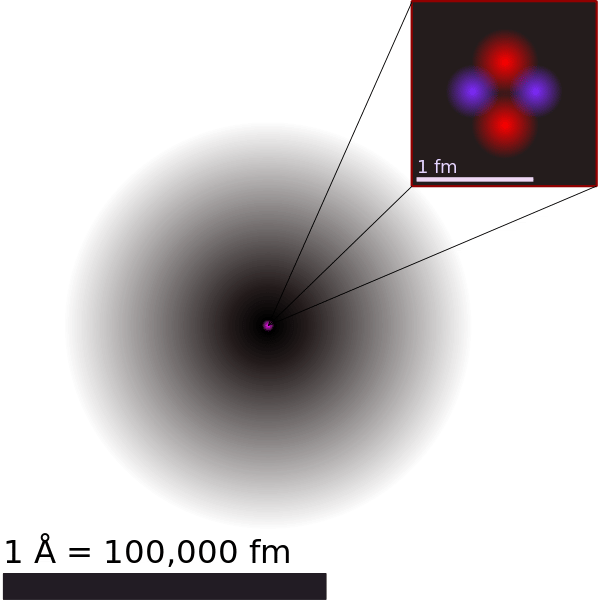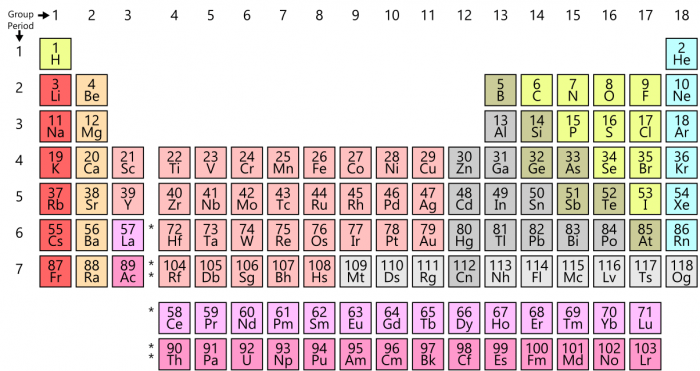
The atomic radius trend describes how the atomic radius changes as you move across the periodic table of the elements. In general, the atomic radius of an element tends to increase as you move down an element group in the periodic table.
To understand why this happens it would be helpful to take a close look at the definition of atomic radius and the radius of different elements in the periodic table.
What Is Atomic Radius?
Atomic radius refers to the size of the atom. Yet this value isn’t as easy to pin down as you might think. First of all, it’s important to be aware of the fact that although the term atomic radius is used to refer to an atom’s size, there isn’t an agreed-upon definition for this value. Various methods of measuring atomic radius are used, including the ionic radius, the metallic radius, the covalent radius, and the Van der Waals radius.
“I must confess I am jealous of the term atom; for though it is very easy to talk of atoms, it is very difficult to form a clear idea of their nature.” — Michael Faraday
Ionic radius refers to the measure of an atom’s ion when in a crystal lattice, and it’s typically half the distance between the nuclei of two different ions which are barely touching. The covalent radius is the size of an atom that makes up a portion of a covalent bond. The metallic radius refers to a specific type of chemical bonding between positively charged metal ions and conduction electrons. The metallic radius is usually defined as being half of the distance between two metal ions adjacent to one another in a metallic lattice. Van der Waals radius refers to the distance that exists between the closest approach of two non-bonded atoms in a defined element.
What Is The Atomic Radius Trend?
While the atomic radius can be defined in a number of different ways, the general atomic radius trend across the periodic table holds true. The atomic radius for atoms of an element tends to go up as you move down a group of elements in the table. The atomic radius increases as you move down a column because for every new row of the table a new electron shell is added to the atom.
A corollary to this is that because there are more electrons per atom as the atomic number increases, the atomic radius may decrease as you make your way across the table left to right.

A rendering of the structure of a helium atom. Atomic radius is calculated by measuring the distance between two nuclei which are barely touching and dividing the diameter in two. Photo: Yzmo via Wikimedia, CC-BY-SA 3.0
How Is Atomic Radius Measured?
Atoms are constantly moving, so that means any attempted measurement of their atomic radius will have a certain amount of error built into it. Measurement of the atomic radius is done by measuring the distance between the nuclei of two different atoms that are just barely touching. The diameter of the distance between the two nuclei is divided by two to get the radius. When measuring atomic radius you must remember that the atoms being measured can’t share a chemical bond between them. This is because a chemical bond means that the electron shells of the atoms overlap or that they share an outer shell.
“All matter originates and exists only by virtue of a force which brings the particle of an atom to vibration and holds this most minute solar system of the atom together.” — Max Planck
Difference Between Atomic Radius And Ionic Radius
Ionic radius and atomic radius is equivalent to any atoms of neutral elements like krypton, neon, and argon. Yet many atoms are the most stable when they have a net positive charge. In practice, this means that they become cations (positively charged ions) when they drop their outermost electron. When the electrons drop from an atom the atom often drops its outermost electron shell as well, which has the effect of making the atomic radius larger than the ionic radius.

Photo: Offnfopt via Wikimedia Commons, Public Domain
In contrast to the fact that some atoms are more stable with a positive charge, some are more stable with a net negative charge. In this case, they become more stable by gaining one or more electrons, turning into anions (negatively charged ions). Another electron shell won’t be added, however, meaning that the size difference between the ionic radius and the atomic radius isn’t as great as the difference that exists in cations. This means that the atomic radius will always be the same or just slightly smaller than the ionic radius. In general, the trend of the ionic radius has a similar trend to the atomic radius, increasing in size as you move across the periodic table.
Other Trends Found In The Periodic Table
There are other trends to be found in the periodic table, apart from the atomic radius trend. Other trends found in the periodic table include the electronegativity trend, the ionization energy trend, and the electron affinity trend.
The electronegativity trend reflects the fact that the electronegativity value of an atom increases as you move left to right across a section of elements. Electronegativity also decreases as you move down a group in the table, from top to bottom. Notable exceptions to the electronegativity trend include Ianthanides, actinides, and noble gases. The transition metals have little variance up in them.
The ionization energy trend refers to how the amount of ionization energy needed to remove an electron from a gaseous neutral atom changes across the periodic table. Elements on the right side of the periodic table usually need more ionization energy to become a cation while elements on the left side of the table typically become cations more easily. In other words, ionization energy increases as one moves across the table from left to right.
“The unleashed power of the atom has changed everything save our modes of thinking and we thus drift toward unparalleled catastrophe.” — Albert Einstein
The electron affinity trend tracks the electron affinity of an atom, the ability of a given atom to bind with an electron. The lower an atom’s electron affinity value, the easier an atom will accept an electron. Electron affinity typically drops as one moves down a group of elements. As you move left to right across the periodic table electron affinity increases.
Examples Of Atomic Radius
Let’s take a quick look at some examples of atomic radius. These atomic radii are measured in picometers:
- The element Hydrogen (H) has an atomic radius of 37.
- Sodium (Na) has an atomic radius of 186.
- Potassium (K) has an atomic radius of 227.
- Rubidium (Rb) has an atomic radius of 248.
- Cesium (Cs) has an atomic radius of 265.
Note that these elements are all found in the first column of the periodic table and that they are presented in descending order. This neatly shows how atomic radius increases as you move down the periodic table.









